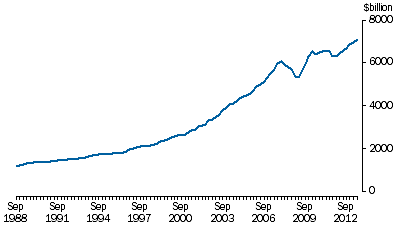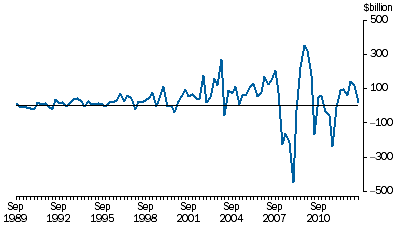QUARTERLY HOUSEHOLD BALANCE SHEET
INTRODUCTION
Household wealth and its impact on consumption and saving are explained annually via publication of a complete Household Balance Sheet and an associated Analytical Measures of Household Income, Consumption, Saving and Wealth table in Australian System of National Accounts (cat. no. 5204.0). Changes in wealth can have a significant impact on economic behaviour including both consumption and saving: during and immediately after the Global Financial Crisis, sharp declines in household wealth were observed which coincided with changes in household consumption and saving behaviour.
Until now, the ABS only published quarterly statistics on stocks of financial assets and liabilities for the household sector. Omission of non-financial assets means users are unable to analyse the short-run impacts of changes in wealth on household consumption and saving via a complete balance sheet. Non-financial assets are approximately two-thirds larger than the value of financial assets, and their absence from the quarterly dataset is a significant data gap.
Publication of a quarterly household balance sheet in turn allows a quarterly table of analytical measures to be compiled. Changes in balance sheet aggregates and net worth positions are of key interest, particularly because of the potential size of holding gains relative to transactions in driving changes in net worth.
The publication of these tables will improve the capacity to formulate policy in response to dynamics of income, wealth, consumption and saving: users will be able to develop a deeper understanding of drivers of short run changes in household wealth, and how changes in household wealth through mechanisms such as fluctuations in property prices or equity values can in turn explain changes in household consumption and saving patterns.
CONCEPTS
Balance sheets present stocks of assets and liabilities as at the date for which the balance sheet is compiled. The entries for the closing balance sheet are the sum of the entries in the opening balance sheet plus transactions reflected in the accumulation accounts (the capital account and financial account), plus entries in the other economic flows accounts (the other changes in the volume of assets account and the revaluations account). The balancing item is net worth, representing the difference between total assets and total liabilities.
An accompanying table of analytical measures estimates the impact of real holding gains and losses and other changes in wealth and integrates these with traditional measures of income and saving. Holding gains and losses are excluded from the national accounts income measure as they do not result from production but from price change. For some purposes it may be useful to use a broader definition of income which includes holding gains, such as that presented in the analytical measures table, where the balancing item is Net saving plus other changes in real net wealth. Because the impact of real holding gains on economic activity may not be equivalent to income received in cash or in kind, the measures introduced in this table should not be seen as replacing or correcting the traditional income and saving measures. Rather, they are provided to give users an alternative view of the available information.
GLOBAL FINANCIAL CRISIS
During the recent global financial crisis, household net worth fell for five consecutive quarters beginning in March 2008. The largest decrease was in December 2008, driven by falls in the value of land, superannuation and shares and other equity. Much of the decline in household net worth in December 2008 is explained by other economic flows. Large total real holding losses occurred in that quarter, with the major contributions being real holding losses on land and financial assets. These large real holding losses are evident in the balancing item, Net saving and other changes in real net wealth, which was negative in December 2008.
Households tightened their belts in response, reducing growth in final consumption expenditure and increasing saving. The saving response was significantly aided by Commonwealth government economic stimulus payments to households. This change in behaviour helped reconsolidate the household balance sheet position, with household net worth rebounding by the end of September quarter 2009. By the end of June quarter 2010, household net worth had increased by $806.2 billion compared to one year earlier. While this was largely due to real holding gains on land ($546.7 billion over the year), the continuation of moderate growth in household final consumption expenditure also played a part.
HOUSEHOLD NET WORTH
 HOUSEHOLD NET SAVING PLUS OTHER CHANGES IN REAL NET WEALTH
HOUSEHOLD NET SAVING PLUS OTHER CHANGES IN REAL NET WEALTH

CONCLUSION
The publication of a quarterly Household Balance Sheet and an associated Analytical Measures of Household Income, Consumption, Saving and Wealth table will enhance the ability to formulate policy in response to short run dynamics of household income, consumption, saving and wealth.
These tables will be published for the first time in the September quarter 2013 issue of 5232.0
Australian National Accounts: Financial Accounts in December.
For further information and to provide comments regarding the quarterly Household Balance Sheet and the Analytical Measures of Household Income, Consumption, Saving and Wealth table, please contact Jason Annabel
<j.annabel@abs.gov.au> or the National Information and Referral Service on 1300 135 070.
 Print Page
Print Page
 Print All
Print All